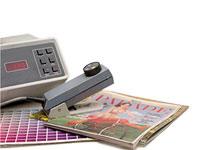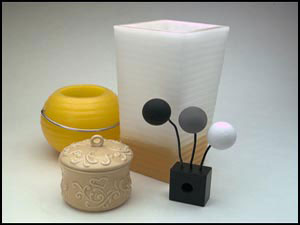Measured Photography
Why should anyone consider a MegaVision workflow? What does MegaVision offer that is worth consideration over the digital capture solutions available from other vendors? 
MegaVision has been conceiving, designing, and refining digital capture tools and software since the beginning of the genre. No one has more experience making and selling digital capture than MegaVision. MegaVision's Tessera was the first digital camera offered for sale in 1987. Since Photoshop and modern computers didn't exist, MegaVision made their own image processor, the 1024XM, and Capture Station software. Since Bayer pattern sensors had yet to be implemented commercially, MegaVision mechanized a rotating filter wheel to provide complete filtering of each channel, synchronizing multiple strobe flashes via an infra-red wireless interface, for red, green, and blue filters. Without guidance from other pioneers, MegaVision implemented their understanding of technology to provide the world's first commercially viable digital camera. 
MegaVision's mantra in the early 1990's was Measured Photography. Measured photography involved understanding the target from the printing press operator's point of view, and it involved a measured validation that the picture file fit the target's measured characterization. Because newprint, calandared web, coated web, and sheet fed presses have different amounts of measureable total ink density and different tonality that can be rendered, MegaVision's digital capture file needed to match the specified press, which is why our modern Photoshoot capture application's contrast is specified in D-log density. This was and still is a very accurate way to specify a picture because it's also perfectly suited to our modern photo targets-- inkjet glossy, matte, fine art and RA-4. All that's needed is a density measurement of your intended target for Photoshoot's density range setting. In the earliest days of digital capture, before anyone had evolved any kind of workflow; before Photoshop, prior to modern computers, calibrated displays, and color management (no small challenge in those early days)-- some sort of viable methodology had to be conceived. The pictures had to be right or the fledgeling digital capture concept would fail. The press community was required to accept the new workflow, as did the pre-press folks, because of the cost savings compared to a film based workflow. Photographers had to accept digital catpure too, which they often eyed with deep suspicion, so assistants were often asked to do the shooting . MegaVision chose to ask photographers, in those earliest days of digital capture, what they wanted. This was a novel concept in the printing or photographic industry; asking the folks who would use a product, what they wanted it to contain and how it should work. What MegaVision did not choose is a scanner interface, specifically because photographers were far more comfortable with a photographic interface. Since photographers were a key component of the new digital capture concept, MegaVision did not feel that it was prudent to force shooters to use an unfamiliar interface. 
Most digital capture applications involve a scanner interface, including a curve box and a levels based densitometer. While this is OK at best for scanning film where the contrast and color are already established in the emulsion and operators are looking for channel based information, it's not especially good for making images where professional lighting contol is assumed and luminance based densitometer reporting can be used to validate the lighting. MegaVision chose a Polaroid-stlye digital proof image, with a luminance based densitomter-- the same interface we use today. Those early days featured capture devices that had barely enough signal-to-noise performance to make a picture. The construction of a "digital emulsion" for the newprint target was straighforward because there was no flexibility and no extra tonality to be used for higher ISO's or smoother transitions to highlight. Today, things are different-- we have excess S/N relative to the reflective target, and we can use it to fashion any kind of digital emulsion that strikes our fancy. All we need to know, is how to make that digital emulsion. Using Measured Photography, we can characterize our target and validate that our capture fits it perfectly. 
In the earliest days of digital capture it was not simple to make a professional picture. Everything had to be done right, and it required a professional photograher because an advanced amateur wasn't good enough. With this reality in mind, MegaVision designed tools and software for the professional shooter. They were tools that professional photographers understood. Digital capture tools today are trumpeted by marketing to be incredibly easy!, astonishingly fast!, and let's not forget-- stylish! What has taken most of us a lifetime of hard work to accomplish is now marketed to be accessible by anyone so lucky or astute enough to purchase the latest, greatest, capture device. Truth be known; photography is still a craft and everything has to be done right. There are a lot of choices to be made and cameras are not good at making the critical choices, such as where the light should come from, how much fill to use, or where are the highest and lowest important values. At the very higest levels, cameras don't make pictures, people do. MegaVision's Measured Photography concept depends on your input. The tools are advanced in that they allow and help you craft your vision, specifically for your target. If this is the kind of picture making you're interested in, you might want to take a look at what we have to offer. |

